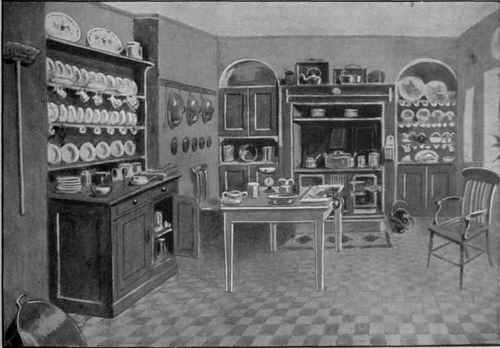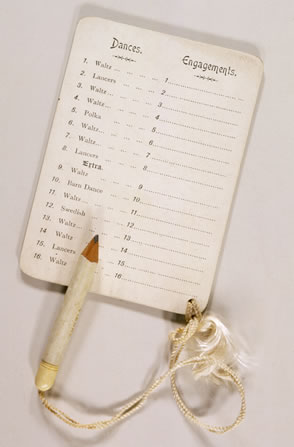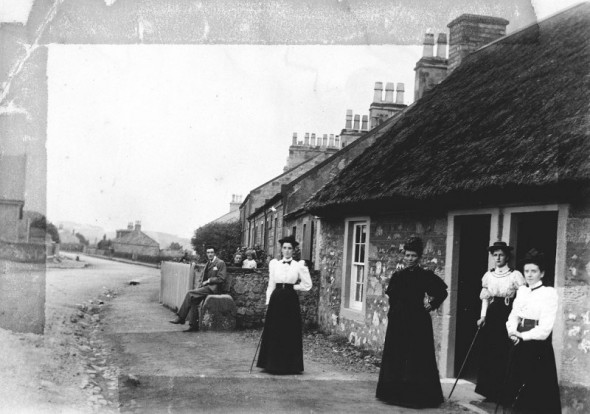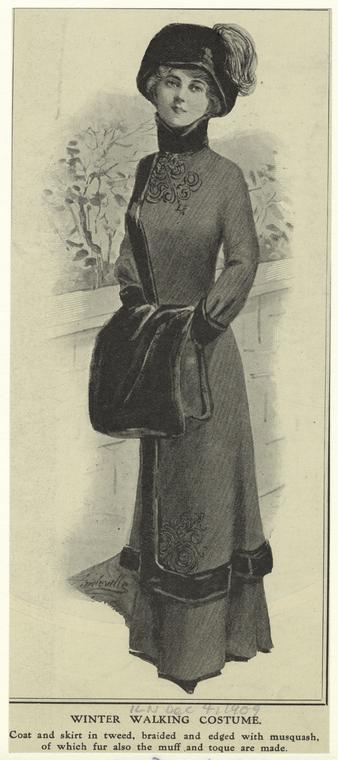
In winter, the beautiful autumn leaves dangle limply from tree branches and pile damply across streets and lawns. The vibrant colors and muted tones, and the brisk weather have ended in the dark, cold, chilly, sometimes rainy, sometimes snowy, snap of winter. Keeping warm in the 21st century can be as easy as hopping into a warmed-up car or turning up the thermostat before tumbling into a cozy bed. It was not that easy for the Edwardians–particularly Edwardians of the lower and servant classes. There also wasn’t the option of hopping into a warmed-up car for well-to-do Edwardians either, since motorcars of the day were still open! And though many modern conveniences of 2014 were beginning to enter the 1900s home, they were usually expensive, risky, or only welcome into the dwellings of the progressive (though, even in the dwellings of progressive Edwardians, the servants were stuck with old-fashioned ways of keeping warm).
Methods of Keeping Warm
The Warming Pan: “The pan or bowl is usually made of copper and is circular in shape, about 12″ in diameter and 4” deep. It has a hinged top or cover which is perforated and on which are etched quaint designs in landscape scenes intermingled with many of the old-fashioned flowers of our grandmothers’ day—phlox, Sweet William, bleeding heart and marigold. The handle is about 4′ in length and was sometimes made of oak, although the better quality warming pans usually had a mahogany handle richly carved in ornate designs. This adjunct to the household of other days always hung by the open fireplace where it was “right handy” to be mustered into service at any time. It was always kept highly polished and formed, as it hung on the wall, a cheerful disc to reflect the light of the glowing fire.” Hot coals were heaped inside of the warming pan and the pan was placed between the sheets well in advance of the occupant’s arrival.
Foot-warmers:
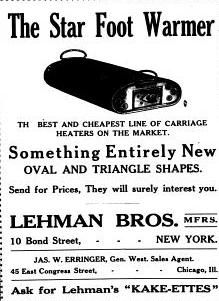
This is an American advertisement for a modern footwarmer. The older footwarmer was a tin box in a wooden frame, in which hot coals were stored. Once placed inside the carriage, the occupants set their feet on either side and spread a blanket over their laps, thus directing the heat from their feet up! You read more about this and see pictures on this website. Edwardian era footwarmers (in railways carriages at least) were warmed by steam run through pipes, and kept hot by a mixture of soda and water. Many automobiles styles featured compartments for smaller versions of footwarmers, but motorists were advised to supplement their heat with thick socks and motoring boots.
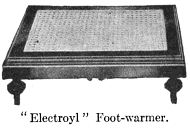
The electric foot-warmer was “made in various forms and sizes… [t]his has a mahogany frame on short feet, with a cane top, the heating element being placed underneath. With such a heater, it is impossible for the feet to remain cold, yet the cost of running is but a fraction of a penny per hour. Such heaters are also convenient for keeping dishes or plates warm, and for airing small articles of clothing, while if placed in the linen closet, they will keep the sheets and house linen beautifully warm and aired.”
Open fires: This has long been the traditional method of heating the home and the body. Fireplaces were heated with coal during the Edwardian era, and during shortages (from strikes or wartime), only the wealthiest homes could afford the sharp rise in prices. The downside to the fireplace was that it required constant tending to keep alive throughout the day and night. This is why maids of some type (housemaids, tweenies, charwomen and parlourmaids) were found in households with a variety of income levels, and the shift to “labor saving” homes via electricity was due to the shortage of servants that began in the late 19th century.
Stoves: In a small dwelling, the stove could keep the home warm. These were lit by coke or coal, gas, or oil. Stoves were cheaper to run than fireplaces, but there was a risk of nasty scents or stuffy ventilation.
Central Heat: yes, this did exist! Heat was transmitted through the walls via hot water pipes: “There are two systems employed, known as the low-pressure and the high-pressure systems. In the former there is usually a boiler in one of the cellars (fed from a separate cistern which must be as high up as possible) from the upper end of which a pipe runs, sending out branches to all parts of the house; these branches bend back and return underneath, finally uniting into another single pipe, which re-enters the boiler at the bottom: so that in each room there is always this double row of pipes…The second method, known as the high-pressure system, is somewhat different. In this case the pipes conveying the hot water actually pass through the kitchen fire. There is no boiler, and a very much greater amount of heat is obtained, while less piping is necessary.” This was of course very costly, and was often found in brand new dwellings. Some older dwellings had “the wormboiler system, which consists of a coil of piping within the kitchen boiler constituting the worm, supplied with water from the cistern at the top of the house, the boiler itself being supplied by a small cistern near the range.” The availability of central heat was an attraction to the luxury apartment flats beginning to intrude upon major English cities.
Clothing: Wool and fur were the rule of the day. Woollen underclothing made by the Jaeger company were popular all year-round as necessary for keeping people cool in the summer and warm in the winter (it was to wick the sweat and to trap the heat, respectively). Thick coats and even thicker socks were worn by all classes and sexes. Furs of all kind were fashion statements, but more importantly, they kept one nice and toasty. Motorists were advised to wear fur-lined gloves and boots, as well as veiled hats, and waterproof coverings to keep warm (remember the open cars). Sturdy leather boots and shoes were a must, particularly for those who lived through wetter winters.
As you can see, the methods for keeping warm in the Edwardian era weren’t too different from today!
Further Reading:
The Book of the Home by H. C. Davidson
House Beautiful v24-25
Keeping Warm in a Colonial Winter by George Wilson Jennings – House & Garden
Electric Cooking, Heating, Cleaning, Etc by Maud Lucas Lancaster
Motor Age v21


